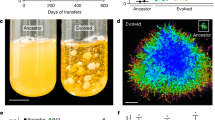Abstract
The transition from unicellular to multicellular organisms is one of the mysteries of evolutionary biology. Individual cells must give up their rights to reproduction and reproduce instead as part of a whole. I review and model the macrocyst stage in slime mould (Dictyostelium) evolution to investigate why an organism might have something to gain from joining a collective reproduction strategy. The macrocyst is a reproductive cartel where individual cells aggregate and form a large zygotic cell which then eats the other aggregating cells. The offspring all have the same genetic code. The model is a steady state genetic algorithm at an individual cellular level. An individual’s genetic code determines a threshold above which it will reproduce and a threshold below which it will join a macrocyst. I find that cycles in food availability can play an important role in an organism’s likelihood of joining the macrocyst. The results also demonstrate how the macrocyst may be an important precursor to other cooperative behaviours.
Access this chapter
Tax calculation will be finalised at checkout
Purchases are for personal use only
Preview
Unable to display preview. Download preview PDF.
Similar content being viewed by others
References
Armstrong, D.P.: Why don’t cellular slime molds cheat. Journal of Theoretical Biology 109, 271–283 (1984)
Baldauf, S.L., Roger, A.J., Wenk-Siefert, I., Doolittle, W.F.: A kingdom level phylogeny of eukaryotes based on combined protein data. Science 290, 972–977 (2000)
Bedau, M.A., McCaskill, J.S., Packard, N.H., Rasmussen, S., Adami, C., Green, D.G., Ikegami, T., Kaneko, K., Ray, T.S.: Open problems in artificial life. Artificial Life 6, 363–376 (2000)
Bonner, J.T.: The origins of multicellularity. Integrative Biology 1, 27–36 (1999)
Bozzone, D.M., Bonner, J.T.: Macrocyst formation in Dictyostelium discoideum: Mating or selfing? The Journal of Experimental Zoology 220, 391–394 (1982)
Buss, L.W.: Somatic cell parasitism and the evolution of somatic tissue compatibility. Evolution 79, 5337–5341 (1982)
Buss, L.W.: The evolution of individuality. Princeton University Press, Princeton (1987)
Chae, S.C., Inazu, Y., Amagai, A., Maeda, Y.: Underexpression of a novel gene, dia2, impairs the transition of Dictyostelium cells from growth to differentiation. Biochemical and Biophysical Research Communications 252, 278–283 (1998)
Di Paolo, E.: A little more than kind and less than kin: the unwarranted use of kin selection in spatial models of communication. In: Floreano, D., Nicoud, J.-D., Mondada, F. (eds.) ECAL 1999. LNCS, vol. 1674, pp. 504–513. Springer, Heidelberg (1998)
Frank, S.A.: Foundations of Social Evolution. Princeton University Press, Princeton (1998)
Hirose, S., Inazu, Y., Chae, S., Maeda, Y.: Suppression of the growth/differentiation transition in Dictyostelium development by transient expression of a novel gene, dia1. Development 127, 3263–3270 (2000)
Kerszberg, M., Wolpert, L.: The origin of metazoa and the egg: a role for cell death. Journal of Theoretical Biology 193, 535–537 (1998)
Kessin, R.H.: Dictyostelium: Evolution, Cell Biology, and the Development of Multicellularity. Cambridge University Press, Cambridge (2001)
Marée, A.F.M., Panfilov, A.V., Hogeweg, P.: Migration and thermotaxis of dictyostelium discoideum slugs, a model study. Journal of Theoretical Biology 199, 297–309 (1999)
Marshall, J.A.R., Rowe, J.E.: Viscous populations and their support for reciprocal cooperation. Artificial Life 9, 327–334 (2003)
Maynard Smith, J., Szathmáry, E.: The Major Transitions in Evolution. Oxford University Press, Oxford (1995)
Michod, R.E.: Cooperation and conflict in the evolution of individuality. ii. conflict mediation. Proceedings of the Royal Society of London: Series B: Biological Sciences 263, 813–822 (1996)
Okada, H., Hirota, Y., Moriyama, R., Saga, Y., Yanagisawa, K.: Nuclear fusion in multinucleated giant cells during the sexual development of Dictyostelium discoideum. Developmental Biology 118, 95–102 (1986)
Pfeiffer, T., Bonhoeffer, S.: An evolutionary scenario for the transition to undifferentiated multicellularity. Proceedings of the National Academy of Sciences of the United States of America 100, 1095–1098 (2003)
Queller, D.C.: Relatedness and the fraternal major transitions. Philosophical Transactions of the Royal Society of London. Series B. 355, 1647–1655 (2000)
Queller, D.C.: Genetic relatedness in viscous populations. Evolutionary Ecology 8, 70–73 (1994)
Raper, K.B.: The Dictyostelids. Princeton University Press, Princeton (1984)
Stewart, J.: Evolutionary transitions and artificial life. Artificial Life 3, 101–120 (1997)
Travisano, M., Velicer, G.J.: Strategies of microbial cheater control. Trends in Microbiology 12, 72–78 (2004)
Wallace, M.A., Raper, K.B.: Genetic exchanges in the macrocysts of Dictyostelium discoideum. Journal of General Microbiology 113, 327–337 (1979)
West, S.A., Pen, I., Griffin, A.S.: Cooperation and competition between relatives. Science 296, 72–75 (2002)
Wolpert, L.: The evolution of development. Biological Journal of the Linnean Society 39, 109–124 (1990)
Author information
Authors and Affiliations
Editor information
Editors and Affiliations
Rights and permissions
Copyright information
© 2005 Springer-Verlag Berlin Heidelberg
About this paper
Cite this paper
Bryden, J. (2005). Slime Mould and the Transition to Multicellularity: The Role of the Macrocyst Stage. In: Capcarrère, M.S., Freitas, A.A., Bentley, P.J., Johnson, C.G., Timmis, J. (eds) Advances in Artificial Life. ECAL 2005. Lecture Notes in Computer Science(), vol 3630. Springer, Berlin, Heidelberg. https://doi.org/10.1007/11553090_56
Download citation
DOI: https://doi.org/10.1007/11553090_56
Publisher Name: Springer, Berlin, Heidelberg
Print ISBN: 978-3-540-28848-0
Online ISBN: 978-3-540-31816-3
eBook Packages: Computer ScienceComputer Science (R0)




